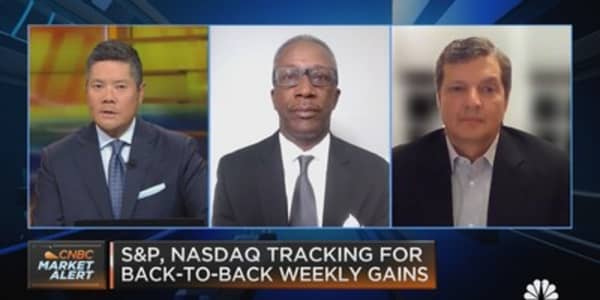If you're like many Americans, you might have a dozen or more jobs during your lifetime. And with each new employer, you might have had the chance to start a 401(k) retirement savings plan. How many old 401(k) accounts are now lurking in your past?
According to a 2013 study by ING Direct USA, half of Americans who have participated in a 401(k) plan have left one behind at a former employer. Of those, almost 20 percent left behind an account worth more than $50,000.
The problem with leaving 401(k) accounts behind, said financial advisors, is that out of sight often means out of mind. Investors may no longer be managing those retirement assets appropriately. They may have picked one investment strategy in their 20s, but by their 40s and 50s, those assets might still — incorrectly — be invested the same way.
"When your [retirement assets] are all split up in different accounts, then you can't rebalance or have a consistent allocation plan," said David Shotwell, a registered investment advisor with Shotwell Rutter Bauer.
The easiest option for your retirement assets is to leave the 401(k) where it is. If your former employer has a plan that's low cost and has a strong menu of investment choices, that could be a wise choice, said certified financial planner Rebecca Kennedy, founder and principal of Kennedy Financial Planning.
"If there's a great plan in place, and they're not going to be charged any extra administrative fees, I don't see a rollover as a necessity," Kennedy said.
Some plans have institutional share classes with rock-bottom fees. That's something investors can't replicate on their own.
What's more, added Kennedy, some clients don't have the energy for making a move. She worries they may not follow through on a recommendation for a rollover, abandoning the process midway. That could result in penalties and taxes. Even worse, the money would no longer be invested in a tax-sheltered account.
More from FA Playbook:
Have a pension? Know your payout options
The hidden costs of buying your own home
Time to up young doctors' financial literacy skills
"I've had [clients] come close to making a mistake with a rollover," Kennedy said. "The money was supposed to be sent directly to an IRA [individual retirement account], but it wasn't. And it took them a long time to move the money."
But staying put doesn't mean being inactive. It's still necessary to take an active interest in the portfolio, making changes to the investment mix as you age and rebalancing periodically.
Another possibility is to roll over an old 401(k) into your current plan, as long as your company allows it. This is only worth doing if the new plan is lower-cost and has better investment choices than the old one.
One important argument in favor of leaving 401(k) assets where they are is if you're over 55 and think you might want to start taking distributions. You can do so penalty-free from a 401(k) plan, but not until age 59½ from an IRA.
"If you're in that age range and you may need to access your money, you would not want to do a rollover regardless of the improved investment offerings," Shotwell said.
Lower fees, better choices
A rollover into an IRA — the option that many financial advisors endorse — can help simplify your life, for sure. It can also help improve the quality of your investments.
Even the best 401(k) plans have a limited menu of investment choices. But IRAs give you a wide world of options, including individual stocks.
For financial advisor Kevin Reardon, president of Shakespeare Wealth Management, a compelling reason for doing a rollover is the access to alternative investments. He believes that most of his clients need exposure to real estate, but many 401(k) plans are lacking even mutual funds of real estate investment trusts.
"And if they have a REIT [real estate investment trust] fund, they'll only have one REIT fund," Reardon said. "But we may want to diversify further than that."
Some clients even want to take an extra step and invest directly in commercial real estate, Reardon said. That's possible in some IRAs, but not at all with a company-sponsored 401(k) plan.
And a rollover can help you access lower-priced funds. According to Brightscope, which rates 401(k) plans, the average asset-weighted expense ratio paid by 401(k) participants in small plans was 81 basis points and 44 basis points for those in large ones.
In an IRA, though, investors can buy index funds from low-cost providers such as Vanguard and BlackRock. Vanguard's flagship Standard & Poor's 500 fund charges just 16 basis points; BlackRock's iShares Total Market exchange-traded fund only costs 3 basis points.
While a rollover may help you simplify your life and even improve the quality of your investments, it can be risky. The problem is in how the money is moved. If the proceeds are paid to you directly, you have 60 days to move it over to an IRA. Otherwise, you'll owe taxes and penalties if you are younger than 59½. A direct rollover, from the 401(k) into an IRA, sidesteps that possibility.
Rollovers under a microscope
The soon-to-be enacted fiduciary rule may slow down rollovers, or at least make advisors think twice about recommending them. The Department of Labor's rule change, set to go into effect in April, will require anyone working with retirement assets to act as a fiduciary. They must put retirement savers' interests first.
Brokers may stop recommending rollovers when employees leave a company. It's hard to know whether the recommendations are in the best interest of employees or due to the broker's commission.
"There's definitely going to be more scrutiny," said Reardon. "There's always been the question about whether or not [a rollover] is the right thing to do.
"There will be more documentation required now."
— By Ilana Polyak, special to CNBC.com




